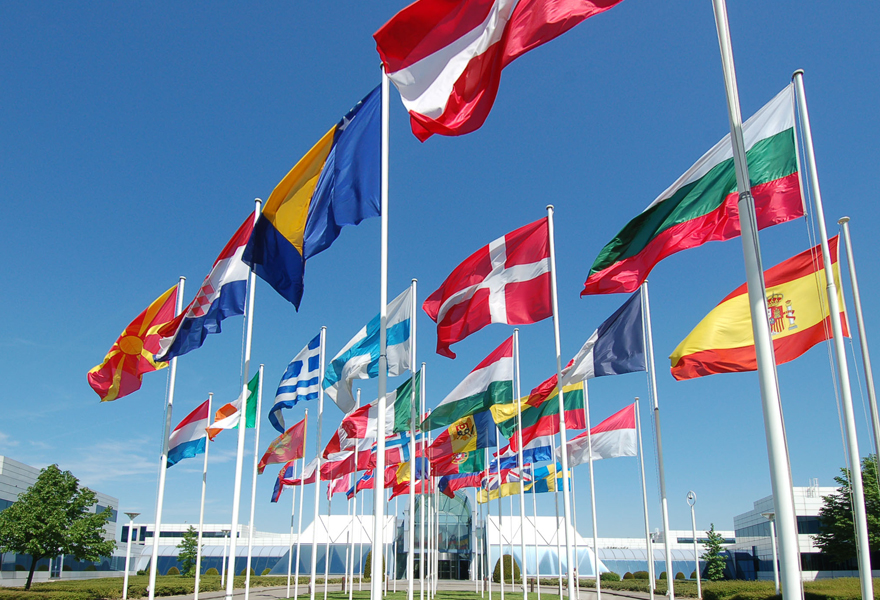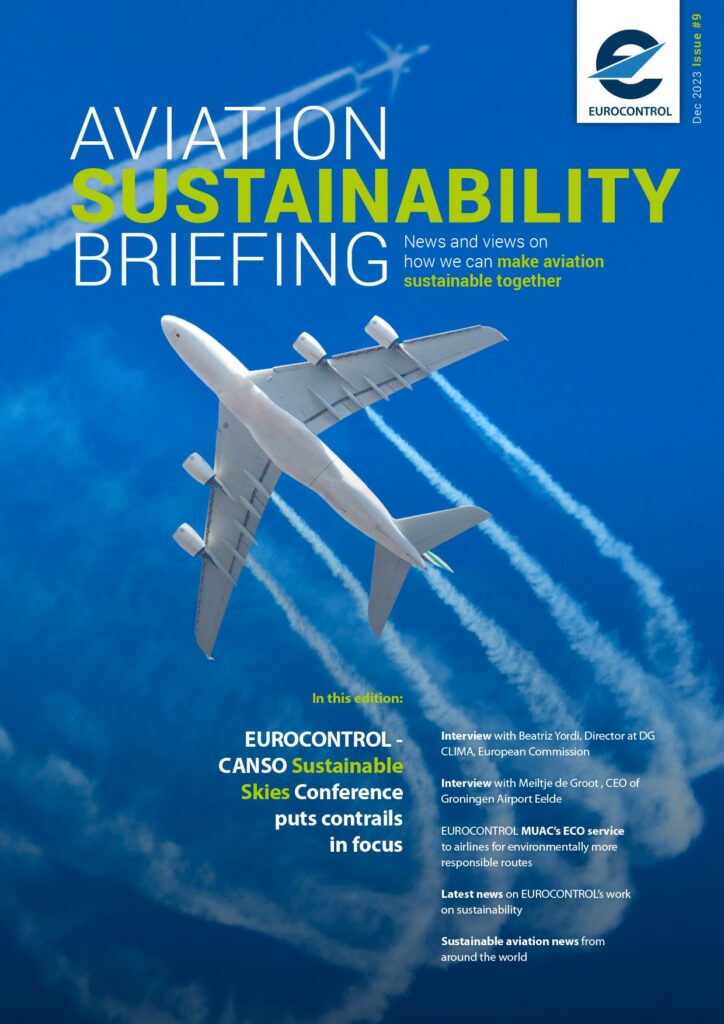Located next to NATO in Brussels, EUROCONTROL’s headquarters is a huge white building with a somewhat austere appearance, but once inside, the atmosphere is very different, with a particularly warm welcome and decor.

We wait for the lift under the benevolent eye of an imposing A380. Upstairs we have a meeting with Marylin Bastin, Head of Aviation Sustainability and Interim Director European Green Sky at EUROCONTROL.
The topic for the day is, of course, the decarbonization of aviation, undoubtedly one of the biggest challenges facing global aviation.

To contribute to decarbonization, the aviation industry and ICAO have adopted an action strategy based on 4 pillars: technological advances, infrastructure improvements, sustainable fuels and market-based measures.
What do you see as the most advanced and promising pathways?
Although technological advances and « sustainable » fuels should be the main drivers of decarbonization at present, we note that market-based measures (offset mechanisms) are still having the greatest impact. This is because the volume of SAF (sustainable aviation fuels) remains limited.
Between now and 2030, it seems to me that the axis on which we can make progress is ATM, i.e. ensuring that the European network is as efficient as possible, which means optimizing trajectories, making them more predictable, exchanging more information between the aircraft and the ground, and so on. Trajectory optimization now covers the entire flight path of the aircraft and the various phases of the flight. Even if there are still inefficiencies associated with TMAs (such as the climb and descent phases, which are subject to airspace regulations), ATM is undoubtedly one of the tools that can be used to reduce the environmental and climatic impact of air transport in Europe.
In conclusion, while we wait for SAF and more efficient aircraft to enter the market, ATM is certainly one of the most advanced ways to address emissions at source in the short term. However, it is undeniable that SAF will have to play a fundamental role in achieving the 2050 decarbonization targets.
The latest issue of EUROCONTROL’s Aviation Sustainability Briefing looks at the non-CO2 impacts of aviation, including contrails. Can you tell us more?
To reduce its impact, aviation must also limit the non-CO2 effects caused by the combustion of kerosene. These include water vapour, nitrogen oxides and particles.

EUROCONTROL magazine, Decembre 2023.
Condensation trails are formed when atmospheric conditions allow water vapour to condense around the soot in the engine plume, forming water drops, which then freeze into ice crystals. If the surrounding air is sufficiently humid, the condensation trails persist, merge and extend to form ice clouds – called induced cirrus clouds[1].
It is the condensation trails that become permanent that are the problem, as they increase cloud cover. During the day, cirrus clouds reflect the sun’s rays, cooling the climate, but at night they prevent heat from escaping, warming it. Not all contrails have the same effect, and the subject is so complex that it deserves its own article (she smiles).

It is, of course, possible to avoid the areas of the atmosphere where persistent condensation trails form. One of the major debates currently raging among aviation professionals and scientists is whether it is better to avoid these areas by burning more fuel and emitting more CO2. In other words, should we give priority to reducing CO2 or non-CO2 emissions? We don’t know the answer yet.
Could the digitalization of the sector contribute to more optimal, and therefore more sustainable, Air Traffic Management?
Digitalization and data sharing are key elements in optimizing air traffic management. If we take the example of CO2/non-CO2 effects, we need huge amounts of data to identify and understand these phenomena. Artificial intelligence tools help us to speed up the processing of these data so that we can take appropriate action and go further in optimizing air traffic management.
How far along is the SESAR programme?
The SESAR programme is progressing, and we have already generated around one hundred projects, some of which have already been adopted by aviation stakeholders.
Today, SESAR 3 focuses on the modernization of air traffic management and cutting-edge technological solutions for the management of conventional aircraft, drones, air taxis and very high-altitude vehicles.
The SESAR initiative is proving to be an accelerator for research and a catalyst for speeding up the transition to a climate-neutral and digital Europe.
The growth in air traffic seems unstoppable. Unless traffic patterns change, technological advances to reduce emissions will not be able to offset the emissions generated by additional flights. What do you think?
It seems to me that we are missing the real debate, which needs to be more global. Aviation is one of the sectors that contributes to CO2 emissions, and nobody here is questioning that. At EUROCONTROL, we are doing everything we can to fly « better », in other words to optimize the flight to limit the environmental and climatic impacts.
I don’t have a problem with talking about sobriety, i.e. « flying less », but I do wonder about the attention and focus systematically given to aviation when activities in other sectors have a much greater impact.
Within the transport sector, aviation is not the worst pupil. According to the International Energy Agency, transport is responsible for 24% of direct CO2 emissions from fuel consumption, with road vehicles accounting for almost 75% of this.
I’m not saying this to « deflect » the issue, but I prefer to look at mobility and transport as a whole and on a global scale. For the time being, I see the urgent need to decarbonize aviation, accelerate innovation and promote access to renewable energy and green financing.
[1] ENAC Alumni magazine, N°29 The non-CO2 effects of aviation

